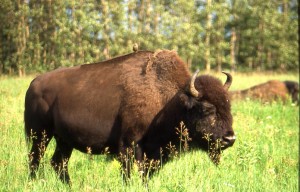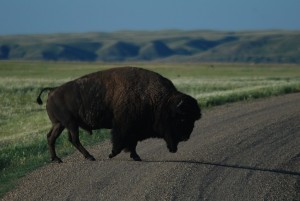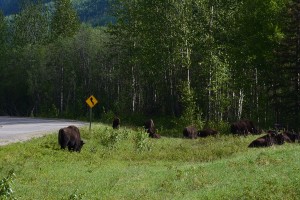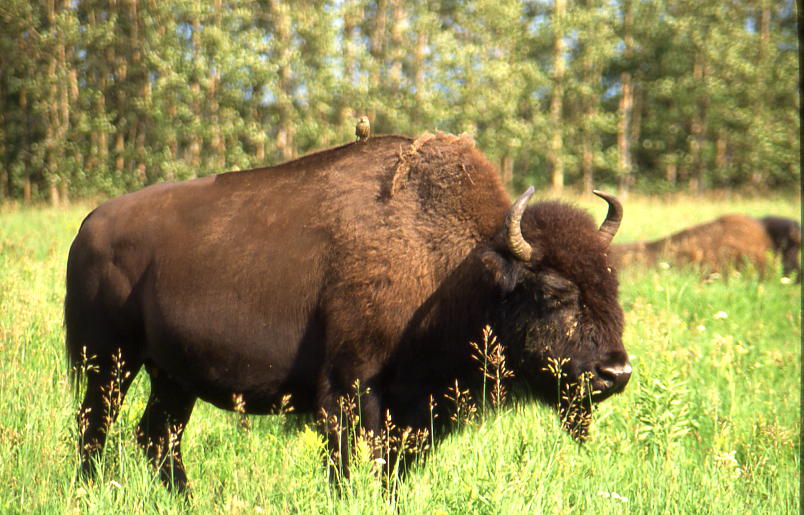
The North American Bison once roamed most of North America and numbered at least 30 million. By the 1890s, they were on the verge of extinction. They were shot by the tens of thousands for their hides, which made warm coats and hats; the carcasses were left to rot. Only about 1,000 animals remained.
So, is it possible to still see free-roaming Bison? Yes indeed. When the hunting stopped, the population began to climb again. There are no longer millions of them, but there are still a few small groups here and there.
Two Types of Bison
There are two different kinds of Bison, but most people would not notice the difference. The Plains Bison has the highest point of its body directly above the forelegs. The Wood Bison has its highest point forward of the forelegs. It is also larger and has larger horns. The most obvious difference is their habitat. As their names describe, the Plains Bison like the open prairie, while the Wood Bison live in the forest.

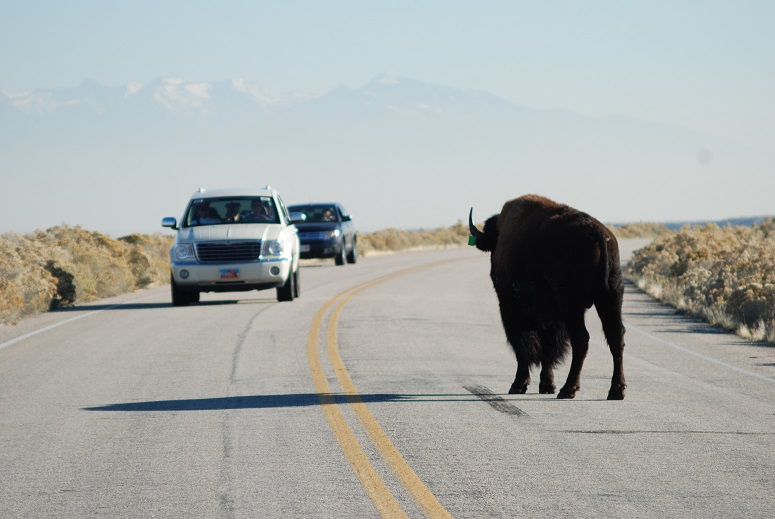
Antelope Island, Utah.
Antelope Island is in the Great Salt Lake, near Salt Lake City, Utah. Although it is an island, there is a causeway and you can drive out to it. It is a great place for hiking, biking, camping and horseback riding. Bison roam free on the island. It is a state park. There are few trees, and at first glance, it does not appear to be a very nice place. But this 28,022-acre island, the largest island in the Great Salt Lake, is hilly and rugged, and there is a lot more to it than first meets the eye. Besides Bison, there are Pronghorn antelopes, deer, bobcats, coyotes, and many birds. There are about 600 Bison on the island. Although they are free-roaming, they are confined to the island. Most people going south for the winter zoom right past it without knowing it is there. I have been there several times, and it is worth stopping. You can combine it with a visit to the impressive Mormon temple in Salt Lake City.
Elk Island National Park, Alberta
Just west of Edmonton, this 194 sq km (75 sq miles) national park is home to more than 400 Bison. The highway runs through the park, with Wood Bison on one side and Plains Bison on the other, so this is a good place to see the difference. There are more than 600 Elk and many birds, including the magnificent Trumpeter Swan. The Bison are free-roaming within the park, but the entire park is fenced. This is a great place to see Bison in the snow. (Did you notice the bird on the Bison’s back?)
National Bison Range, Montana
About 400 Bison roam this reserve as well as numerous other mammals and birds.
Yellowstone National Park, Wyoming
This park is home to the largest herd of Bison in the U.S.A., numbering some 3,000 animals. It is 3,468 sq miles (8,983 sq km) in size. It is also a good place to spot wolves. There are also 600 Grizzly bears and 30,000 Elk.
Wind Cave National Park, South Dakota
Bison and Elk were introduced into this 33,847-acre park in 1913. They now number about 350 animals.
American Prairie Reserve, Montana
This is a fairly new place. It is a private, non-profit organisation with a goal of preserving a three-million-acre property that shows what the North American prairie was like before the intervention of modern society. The idea to create it was made in 1999. The World Wildlife Fund decided to create the reserve, and today it encompasses 274,000 acres and is still in the process of buying more land. In 2010, 94 Bison were acquired from Elk Island National Park in Alberta. More Bison were acquired from Wind Cave National Park in South Dakota. Another 71 Bison were acquired from Elk Island in 2012. The reserve is fenced with a special Bison fence that does not prohibit the passage of other animals such as deer and antelope.
The reserve is also home to other spectacular wildlife such as the Black-tailed Prairie Dog, Burrowing Owl, Long-billed Curlew and many other birds. Future introductions of rare animals will include the Swift Fox and the Black-footed Ferret.
This is a great place. When completed, it will be a North American version of the Serengeti.
Wichita Mountains Wildlife Refuge, Oklahoma
650 Bison live here
Grasslands National Park, Saskatchewan
The park has 70 Bison that roam freely within its fenced 181 sq km (70 sq miles). They were introduced here from Elk Island National Park in 2006.
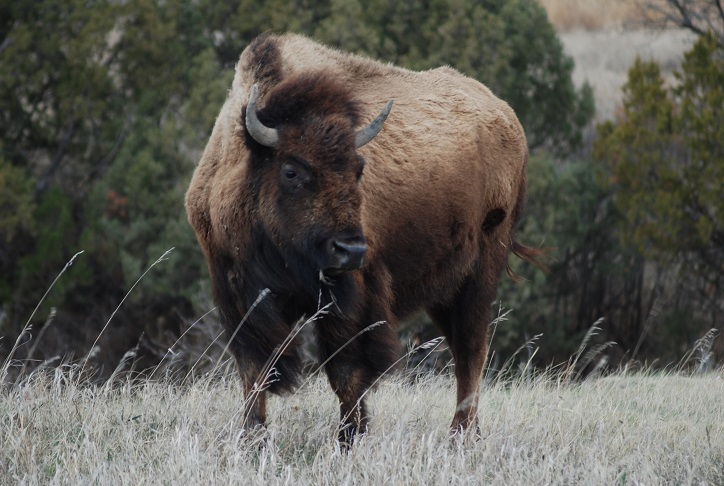
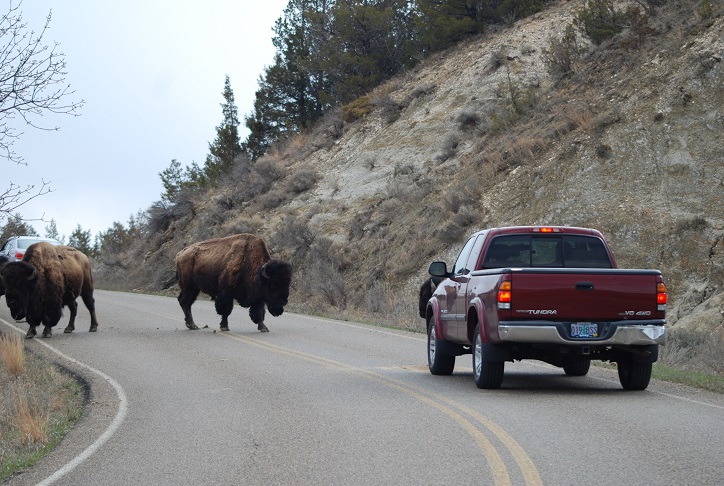
Theodore Roosevelt National Park, North Dakota
In 1956, 29 bison were released in the south unit of Theodore Roosevelt National Park. Here they roamed freely on 46,000 acres of parkland, and by 1962, the herd had increased to 145 animals. That year, 30 animals were relocated to the 24,000-acre north unit.
Wood Buffalo National Park, Alberta and Northwest Territories
This park is home to the largest free-roaming herd of bison in the world, a mixture of plains and wood bison. Plains bison were translocated to WBNP between 1925 and 1928 from Buffalo National Park, which once existed near Wainwright, Alberta. (The former Buffalo NP is now a military base). This park is 44,807 sq km (17,300 sq miles), making it the second largest national park in the world. It contains some 5,000 Bison. (The largest park in the world is in Greenland)
The park is also home to the very rare Whooping Crane, which spends its summers here and its winters in Aransas, Texas.
The park was designated a UNESCO World Heritage Site in 1983. It is in a very remote area and the only road into it approaches from the north.
Prince Albert National Park, Saskatchewan
This park has a population of about 400 Bison. The animals range freely in and out of the park.
Mackenzie Bison Sanctuary. Northwest Territory
The Mackenzie Bison Sanctuary is a protected wildlife reserve located east of the community of Fort Providence, Northwest Territories, Canada. This reserve was established in 1963 and is home to a herd of between 2,000 and 3,000 free-roaming bison. The Mackenzie Bison Sanctuary covers over 10,000 square kilometres. Be alert when driving Highway 3, which borders the reserve, which is not fenced.
Custer State Park, South Dakota
This park has a herd of 1,300 bison that roam freely throughout the park
Lensky Stolby National Nature Park, Sakha Republic, Russian Federation
Three Bison were transferred from Elk Island National Park in Alberta to this park in 2006, 2011, and 2013, for a total of 120 animals. The park is located in the northeast of the Russian Federation and covers an area of 485,000 acres. Apparently, the Wood Bison once lived in both Alaska and eastern Russia, but there have not been any bison in Russia for the past 5,000 years.
Free-roaming Bison not in a park or refuge
There are only a few places to find wild Bison that are not in a park or wildlife refuge.
Henry Mountains, Utah
The Henry Mountains, in south-east Utah, are public lands and are administered by the Bureau of Land Management. About 400 bison are here, but they are difficult to find. They are not tame, and you will not see them standing beside the road like in Yellowstone. These Bison are descendants of 18 animals that were introduced from Yellowstone National Park in 1941 and another five in 1942. They are the only true wild bison in the U.S.A. It is possible to get a licence to hunt them. About 100 permits are issued per year.
Northern British Columbia, Canada
The only other place that I know of to see wild Bison that are not in a park is in north-west Canada. If you drive the Alaska highway in northern British Columbia, you might encounter Bison as you approach the Yukon border. These are true free-roaming Bison. Dive carefully, as they might be standing or sleeping right in the middle of the highway. About 10,000 Bison live in the forest here.
Alaska
There are some small groups of Wood Bison in Alaska, for a total of 900 in the state. I spent one summer in Alaska and did not see any.
Buffalo
This article is about the North American Bison. This animal is often called a Buffalo, but this name is not correct. The Buffalo lives in Africa and Asia.
